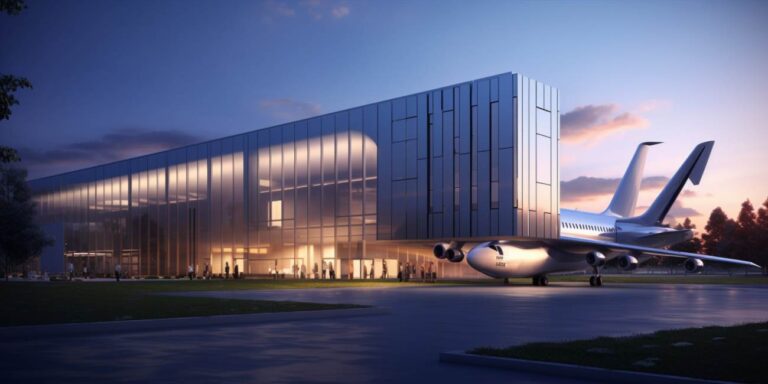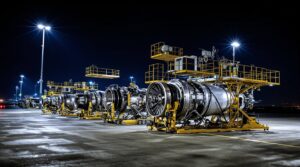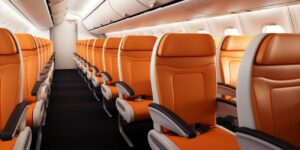One of the key component manufacturing sites for Airbus is situated in Hamburg, Germany. This facility plays a pivotal role in the production of major components, including fuselage sections. The Hamburg site exemplifies the collaborative nature of Airbus, bringing together skilled professionals to contribute to the assembly of cutting-edge aircraft.
Another critical hub in Airbus’s manufacturing network is in Broughton, United Kingdom. Here, the focus is on the production of wings, a crucial element that defines the performance and aerodynamics of Airbus aircraft. The expertise and precision employed at the Broughton facility underscore its significance in the overall manufacturing process.
Expanding its footprint, Airbus has a notable presence in Seville, Spain, where the company’s aerospace excellence extends to the production of vertical tailplanes and the final assembly of military aircraft. The Seville facility showcases Airbus’s commitment to innovation and versatility in meeting diverse aviation needs.
For the production of single-aisle aircraft, Tianjin, China, emerges as a key location. The Airbus assembly line in Tianjin is a testament to the company’s global strategy, fostering collaboration and technological exchange to meet the growing demands of the aviation market in the Asia-Pacific region.
Moreover, Airbus’s global presence extends to the United States, with a prominent facility in Mobile, Alabama. This manufacturing site focuses on assembling A320 family aircraft, contributing to Airbus’s ability to cater to the evolving aviation landscape in North America.
In addition to these major sites, Airbus has strategically positioned engineering and innovation centers across the globe, emphasizing its commitment to continuous advancement in aerospace technology. These centers, including those in Bangalore, India, and Herndon, Virginia, play a crucial role in driving research and development for the company.
Airbus headquarters located in european cities providing advanced technology
The Airbus headquarters are strategically located in several European cities, each playing a crucial role in advancing the aerospace industry with cutting-edge technology. One of the key locations is in Toulouse, France, often referred to as the “Airbus capital.” This city houses the primary headquarters where innovative minds converge to shape the future of aviation.
In Toulouse, Airbus has established a state-of-the-art research and development center, where engineers and scientists collaborate to push the boundaries of technology. This facility serves as the epicenter for breakthroughs in aircraft design, aerodynamics, and propulsion systems. The commitment to pushing technological frontiers is evident in the myriad of patents that originate from this hub.
Another crucial node in Airbus’s technological network is located in Hamburg, Germany. This city is a powerhouse for aircraft manufacturing, with advanced production facilities responsible for assembling key components of Airbus aircraft. The expertise in precision engineering and high-tech manufacturing processes in Hamburg contributes significantly to the overall quality and performance of Airbus airplanes.
For cutting-edge avionics and digital innovation, Madrid, Spain, has become a hub for Airbus. The Spanish capital hosts a center dedicated to developing advanced avionic systems that enhance the safety, efficiency, and connectivity of Airbus aircraft. From flight control systems to advanced communication technologies, the experts in Madrid play a pivotal role in shaping the digital future of aviation.
Additionally, the Airbus headquarters in Bristol, United Kingdom, focuses on research and development of aerostructures. Engineers in Bristol are at the forefront of designing and testing lightweight yet robust materials that form the backbone of modern aircraft. Their innovations contribute to the overall fuel efficiency and environmental sustainability of Airbus airplanes.
Collaboration across these European cities forms a network that propels Airbus to the forefront of the aerospace industry. The synergy between Toulouse’s visionary research, Hamburg’s precise manufacturing, Madrid’s digital expertise, and Bristol’s aerostructural advancements creates a powerhouse that continuously pushes the boundaries of what is possible in aviation.
Moreover, Airbus fosters a culture of international collaboration, bringing together experts from various disciplines and backgrounds. This diverse and dynamic environment stimulates creativity and ensures that Airbus remains at the forefront of technological advancements in the global aerospace landscape.
Airbus factories spread across the globe in america asia europe
Airbus, a global aerospace giant, has established a network of plants strategically scattered across the globe, contributing to its reputation as a leader in the aviation industry. These manufacturing facilities play a pivotal role in the production of various aircraft components, including wing assembly, fuselage sections, and intricate parts that come together to create cutting-edge aircraft.
One of the key hubs in Airbus’s production network is located in Toulouse, France. Here, the company’s headquarters serves as a central point for coordination and innovation. Toulouse is not only the birthplace of iconic Airbus models but also a hub for research and development, where engineers and designers work tirelessly to push the boundaries of aviation technology.
Heading north from Toulouse, we find ourselves in Hamburg, Germany, home to another vital Airbus facility. Specializing in wing assembly, the Hamburg plant is a crucial link in the chain of Airbus’s production process. The precision and expertise exhibited in this facility contribute significantly to the aerodynamic efficiency and structural integrity of Airbus aircraft.
Further north, in Bremen, Germany, Airbus operates a facility focused on manufacturing fuselage sections. This center of excellence plays a vital role in ensuring the robustness and durability of the aircraft’s central structure. Bremen’s contributions to the assembly line are fundamental in achieving the high safety standards that Airbus is known for.
These European facilities represent just a portion of Airbus’s global footprint. Beyond Europe, Airbus has strategically positioned plants in America and Asia, extending its influence and efficiency worldwide. This international network allows the company to tap into diverse talent pools and leverage regional expertise, enhancing the overall quality and innovation of its products.
As we delve into the intricate details of Airbus’s production process, it becomes evident that each plant specializes in a specific aspect of aircraft manufacturing. From wing assembly in Hamburg to fuselage sections in Bremen, and the comprehensive coordination in Toulouse, every facility plays a unique and crucial role in the creation of Airbus’s state-of-the-art aircraft.
Innovative aviation solutions improving flying experience
Revolutionizing the aviation industry, innovative solutions are reshaping the flying experience, addressing key aspects such as design, comfort, technology, efficiency, and environment.
Beginning with design, aircraft interiors are undergoing a paradigm shift. Airlines are collaborating with renowned designers to create cabins that blend aesthetics with functionality. Ergonomically crafted seats, comfortable enough for long-haul journeys, redefine the passenger experience.
The integration of cutting-edge technology is another pivotal aspect. Smart cabins, equipped with touch-sensitive control panels and interactive entertainment systems, offer passengers a seamless and personalized journey. This technology not only enhances the overall experience but also contributes to the efficiency of the flight operation.
Speaking of efficiency, the aviation industry is witnessing a surge in eco-friendly initiatives. Airlines are investing in state-of-the-art aircraft with advanced aerodynamics, leading to reduced fuel consumption and lower emissions. This not only benefits the environment but also aligns with global sustainability goals.
Moreover, the focus on passenger comfort extends beyond seating arrangements. Noise-canceling technologies are becoming standard, ensuring a serene environment during flights. Enhanced air circulation and humidity control systems contribute to a more pleasant and comfortable cabin atmosphere.
Efforts to improve environmental sustainability are evident in the materials used in aircraft construction. Lightweight composites not only enhance fuel efficiency but also reduce the overall environmental impact. Additionally, airlines are adopting greener practices on the ground, such as efficient waste disposal and recycling programs.
Table below illustrates the holistic approach of innovative aviation solutions:
| Aspect | Key Features |
| Design | Collaboration with renowned designers, ergonomic seats |
| Technology | Smart cabins, touch-sensitive control panels |
| Efficiency | Eco-friendly aircraft, advanced aerodynamics |
| Comfort | Noise-canceling technologies, improved air circulation |
| Environment | Use of lightweight composites, eco-friendly ground practices |






